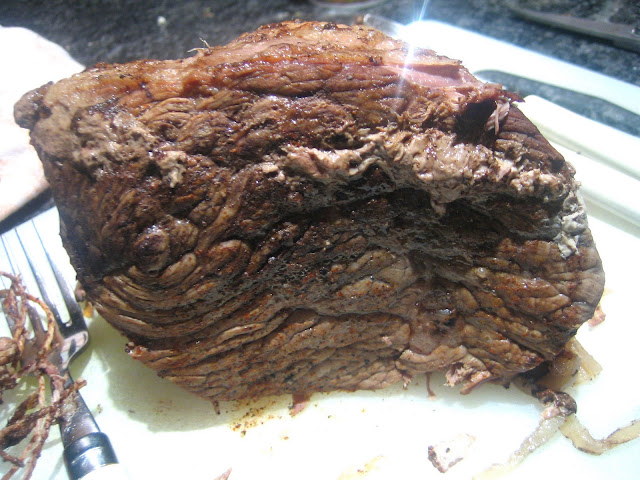 |
| Outside or bottom round |
There are many cultural differences between my home country (Wales) and Canada, many obstacles to navigate and barriers to break down. Opinion is divided on who said it but "Britain and (North) America are two countries divided by a common language" is one of the truest phrases ever uttered. Who would have thought that there were so many different words used to describe cuts of beef? Not me, that's for sure.
It took me ages to work out what everything was translated to and steakhouses would often leave us scratching our heads in bewilderment. Tenderloin, New York, Porterhouse? What? I have since figured it out as far as the more common 'steak' cuts are concerned and can now order with confidence at the best establishments, but, trying to find an elusive piece of beef that Neil's mum uses is proving to be a hard task.
When I once asked her what the stretchy, tender cut she used was, she wasn't sure but thought she may have recalled it being labelled as 'silverside'. Investigations this side of the pond yields no results, it simply doesn't exist and to make matters even more complicated, I have recently discovered from a great new book that the cuts in North America and the UK are different also, not just the names. So, the search continues.
 |
| Outside round roast on day two. Soaked in the cooking liquor and reheated it became much more tender |
According to my book, Plenty by Diana Henry, silverside is cut from the same place as 'round' in North America, but as that piece is much larger in NA, in the UK it could be silverside, top rump or top side. You figure it out!
Anyway, we tried 'outside round' also known as 'bottom round' and were cautiously optimistic. Neil was less than pleased with the cooking instructions we found, suggesting this cut is best as a pot roast, braising in some liquid as this really shatters his idea that all good roast beef must be just that: roast in an oven,dry with the fat and juices dripping onto the fluffy Yorkshire pudding underneath. I tried a recipe anyway. The result was okay, the flavour being a little bland and the texture unusual. The grain of the meat was really prominent but lacked that 'stretchy', tender nature of the mother in laws. Sliced and stored in some of the cooking liquid for a while, it became juicier and tenderer and worked well with some gravy made from the cooking liquor. The roast beef proper of Neil's dreams it wasn't though.
You can see from the photo that the grain is very prominent. Cutting across the grain into thin slices is important to ensure tenderness.
A very useful diagram of the differences between US and UK cuts of beef.
What I have learned about steaks:
North America UK
Tenderloin Fillet
Strip loin, New York Sirloin
Porterhouse T-bone
Sirloin RumpOne of the best roast beef and Yorkshire pudding dinners I have had recently was here. (Scroll down to see) .They said they used sirloin, which would be a large cut of rump in the UK. It was medium rare, juicy and very flavourful.
I have tried in the past to recreate the perfect roast, trying prime rib and brisket, nothing so far has come up to Neil's expectations, then again, it's his mum, perhaps nothing ever will!
 |
| The outside round roast on day 2. The meat was much tenderer after sitting in the sauce overnight and re-heated. |





No comments:
Post a Comment